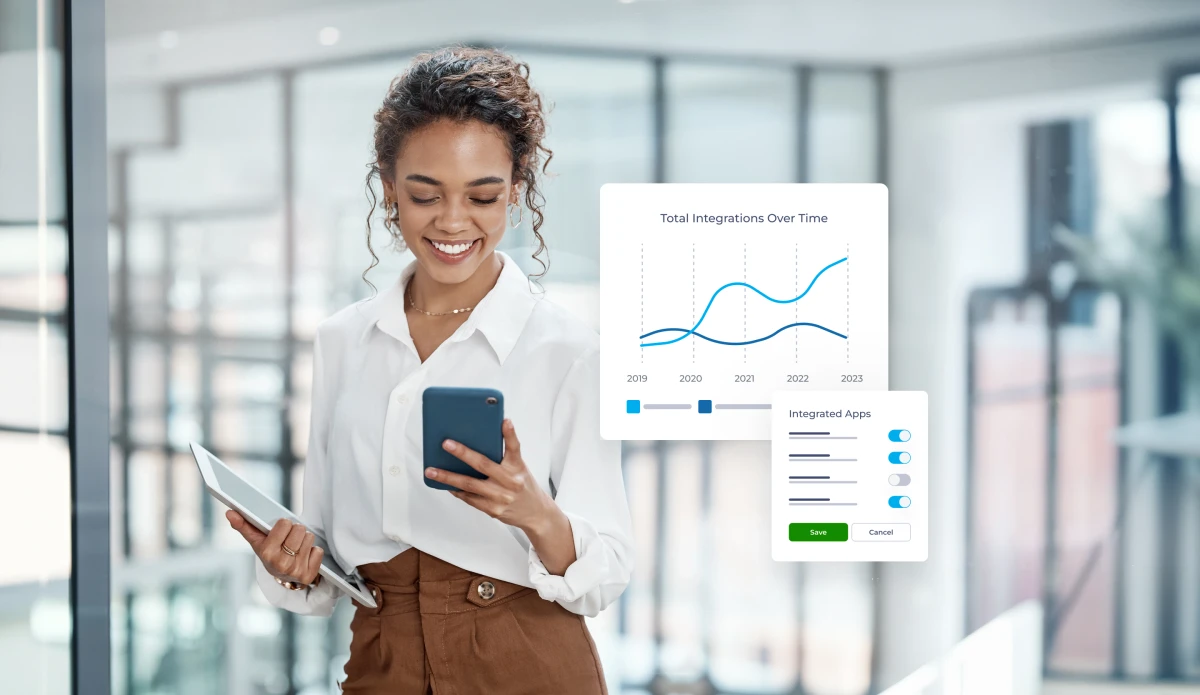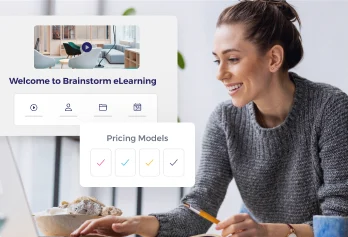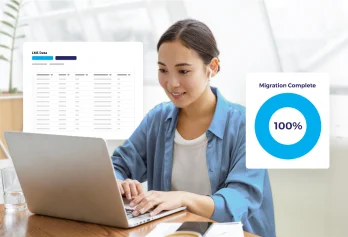Creating a culture of corporate learning is of utmost importance in today's rapidly evolving business landscape. An intentionally created learning culture supported by modern technology fosters continuous growth, innovation, and adaptability within an organization. Supporting this importance of employee adaptability, a study by Gartner anticipates that 58% of the workforce will need new skill sets to do their jobs successfully in the coming years due to the speed of innovation.1
Creating a learning environment that is seamlessly integrated and centered around people is essential for nurturing a thriving organizational learning culture. By embracing transformative tech and incorporating learning management system (LMS) integrations, your organization can revolutionize the way you distribute training, saving valuable time and elevating the overall quality of learning experiences. Nevertheless, it’s important to acknowledge that implementing these integrations is a complex process involving many stakeholders and technical considerations.
In this comprehensive guide, we'll take you through everything you need to know about LMS integrations. From understanding what they are and their benefits to planning and implementing them successfully, this guide will serve as an essential resource for your organization's success.
Maximizing learning platform potential: How LMS integrations transform learning environments
LMS integrations involve linking your LMS with other software tools. Some examples of popular LMS integrations are human capital management (HCM) systems, customer relationship management (CRM) tools, web conference platforms, and content libraries. Learning system integrations improve efficiency among learners and administrators by consolidating learning resources and tools while enhancing the overall learning experience. Integration also supports enhanced enterprise learning scalability and accessibility, making it suitable for hybrid and blended learning models and enabling training for diverse audiences with different learning styles.
Why LMS integrations are vital for modern learning
Integrating your LMS with other systems is crucial for a better eLearning experience. However, for modern organizations and growing companies, learning system integration is quickly becoming a non-negotiable component of the corporate training experience. Here are a few reasons why embracing learning management system integration is a necessary strategic move for growing companies:
- Headless integration: With the support of a headless LMS, your learning platform embeds directly into your native applications where work happens and where learning has the most impact and relevance. This creates an in-the-flow learning experience, allowing users to maximize productivity by learning when the knowledge is most relevant.
- Personalized user experience: For successful organizations, a personalized user learning experience is vital. Integrating your LMS with other tools like HCM software enables targeted employee training and development. Additionally, it supports customized learning paths created based on data like performance metrics to strengthen the eLearning experience.
- Data-driven decision-making: LMS integration also facilitates data-driven decision-making. By collecting and analyzing data on eLearning performance, engagement, and satisfaction, businesses can gain valuable insights into the effectiveness of their learning strategies and make informed adjustments. This data-driven approach empowers educators to continuously improve instructional design, identify areas for improvement, and optimize resource allocation.
- Time-saving administrative tasks: Lastly, by integrating your learning platform with other systems, you support efficient administrative operations.Connecting your digital tools enables seamless data transfer while reducing errors and making onboarding, course enrollment, and completion tracking easier through automated workflows. Implementing an LMS integration strategy leads to increased productivity and success in your training program.
Exploring examples of common learning platform integrations
Learning system integrations play a crucial role in creating dynamic and engaging learning environments. Below we’ll explore a range of common learning platform integrations, highlighting their functionalities and benefits. By delving into real-world examples, we aim to demonstrate how these integrations contribute to an optimal learning experience. Whether it's connecting with productivity tools, incorporating multimedia content, or leveraging analytics, these examples showcase the transformative potential of LMS integrations in modern workplace education.
Human capital management (HCM) systems
Two of the most common learning platform integrations are with your HCM system or human resources information system (HRIS). Some examples of HR system integrations for enterprises and growing companies include ADP and BambooHR. Integrating your LMS and HR platform fuels employee development and provides valuable data on employee performance and skill levels. This integration also makes it possible to create personalized learning paths for each learner by highlighting professional growth opportunities and providing insight to assist with career planning.
Lastly, a major perk of integrating your HR and learning systems is the automation of historically manual tasks. For instance, automated progress tracking and training session reminders save time and are proven to be effective in creating a seamless eLearning experience. Syncing your employee data with your LMS also ensures your learning records correctly reflect compliance training certification and renewals.
Customer relationship management (CRM) systems
Integrating your learning platform with your CRM has numerous benefits for organizations seeking a single source of truth for all their data. It allows for seamless synchronization of learner data, enabling you to capture and consolidate relevant information such as enrollment details, course progress, certifications, and assessment scores in the CRM platform. Additionally, this unified view supports effective tracking, reporting, and analysis across your organization – helping you optimize your training programs and drive meaningful educational outcomes for your employees.
Beyond employee training, many companies leverage CRM tools like Salesforce to train customers and partners. By delivering learning content directly in the CRM tool, you enable users to learn directly in the application. In-the-flow learning lets sales teams, customers, and partners learn in the moment without switching applications, saving time and boosting productivity.
Content library integration
In addition to integrating your learning system with your CRM, connecting third-party content with your LMS supports staff training. LMS content libraries enable organizations to choose from thousands of courses and select subjects that meet learner needs. Integration of content library material can also jumpstart your training program by tapping into proven LMS content and saving you time spent on course authoring.
Furthermore, integrating a content library with your learning platform diversifies the types of eLearning content available to learners, improving their training experience. We recommend prioritizing relevant materials that align with your training program goals and learner needs.
5 Key phases of an LMS integration
To effectively plan an LMS integration, the importance of proactive planning cannot be overstated. Connecting your systems requires careful consideration and a systematic approach to ensure success. To help you get started, our integration specialists at Absorb have outlined the stages you can expect in an LMS integration based on their work across hundreds of clients: scoping, data gathering, testing and validation, deployment, and monitoring.
1. Scoping
During the initial scoping phase, the primary goal is to gather information and define the project's parameters, objectives, and deliverables. In this key phase, you’ll partner with your LMS provider to plan and set project integration goals. By discussing and establishing goals with your LMS provider, you ensure that both parties are on the same page regarding the desired outcomes of the LMS integration. Setting goals with your vendor also allows you to define the desired timelines, functionality, and user experience that you expect from the LMS.
In the scoping stage, you’ll also finalize the systems and data that need to be integrated with your LMS. Start by evaluating your organization’s workflows to identify key training tools. Next, assess your learning needs to identify content, resources, and systems necessary to deliver effective learning experiences like video conferencing tools or external content libraries.
2. Data gathering
The data gathering phase of your LMS integration involves collecting and analyzing information related to your organization's learning and training processes. The purpose of data gathering is to understand the existing systems, processes, and data requirements to facilitate a smooth integration of the LMS with other systems or platforms.
Starting the data gathering process early gives you ample time to deliver files to your LMS vendor and allows you to assess the data structure, format, and quality in both the LMS and the integrated tool. You can identify any inconsistencies, data gaps, or data integrity issues that need to be addressed. It also provides an opportunity to establish data mapping rules to ensure accurate and meaningful data exchange between systems.
3. Testing and validation
Testing and validating your LMS is another key integration step. This crucial phase involves making sure the integrated system performs as expected and complies with the necessary specifications. To do so, you’ll perform various tests to identify and address any issues, ensure data integrity, and validate the system's performance.
Optimizing the LMS integration testing and troubleshooting process requires a comprehensive evaluation of technical components in different environments. Analyzing data transfer trends while ensuring a secure user experience are both important elements of the testing process. We recommend establishing a testing group to help you identify potential issues and ultimately – develop a troubleshooting plan.
4. Deployment
After successful testing and approval from stakeholders, it’s time to launch your LMS integration to your user base. LMS implementation includes making the system accessible to all users, configuring user access and permissions, and enabling any necessary integrations with other systems or tools. The complexity and scope of your LMS integration will factor into your deployment timeline.
5. Monitoring
Continuously monitoring and evaluating your LMS integrations is crucial for success. Regularly checking the functionality of the integration by gathering feedback from learners can provide invaluable insights into their online training experience. Additionally, regular maintenance, updates, and enhancements may also be performed to optimize the system's performance and meet evolving needs.
Strategic steps for seamless LMS integration: Best practices to ensure success
Taking a strategic approach to planning and rolling out your LMS integration will help your users learn the ins and outs of the system quickly and easily. Here are some best practices to implement as you organize and implement your LMS integration:
Engage your IT team and key internal stakeholders
Your information technology (IT) team possesses the technical expertise and knowledge needed to understand the integration requirements, assess compatibility with existing systems, and evaluate the feasibility of the integration project. They can provide valuable insights into the technical aspects, infrastructure considerations, and potential challenges associated with integrating the LMS with other systems. Involving IT professionals early on also allows them to assess security requirements and provide guidance on implementing necessary safeguards to protect data during integration.
Beyond engaging technical experts, it’s important to create a dedicated implementation project team consisting of key stakeholders from various departments, including representatives from human resources, design, and other relevant business units. Assign roles and responsibilities to team members and establish effective communication channels for regular updates and collaboration.
Create a detailed integration project plan
Develop a detailed integration plan that outlines the tasks, milestones, timelines, and dependencies. Consider technical requirements, data integration, customization needs, testing, training, and post-launch support. Ensure that the plan is realistic and allocate resources and budget accordingly.
Request a preparation checklist
Lastly, request an LMS integration checklist from your provider – this will help you address comprehensive planning by outlining the necessary steps, tasks, and considerations required for a successful LMS integration. It may also serve as a communication tool between you and your LMS provider, ensuring a shared (and documented) understanding of the integration process and requirements.
Develop training materials and provide user support
Your LMS integration is a significant change for platform users. By providing user training materials and support, you help learners adapt to the new system and ensure a smooth transition. It also helps reduce the learning curve and shows users how to effectively utilize the LMS – increasing learning platform adoption and instilling learner confidence.
Communicate change management
Change management communication helps set clear expectations about the LMS integration process. It informs stakeholders, such as employees, instructors, or administrators, about the purpose, goals, and timeline of the integration. Clear change management communication ensures that everyone understands what changes to expect, why they are happening, and how it will impact their work or learning processes.
Conclusion: The importance of mindfully integrating your LMS
LMS integrations are essential in today's digital era where there is a constant need to provide learners with personalized, relevant, and engaging content. Integrating different systems and applications helps create a seamless experience for learners and administrators alike by saving time while enhancing the overall learning experience.
If you’re searching for a trusted LMS partner to pave the way for your learning platform integration, look no further than Absorb LMS. Our cloud-based LMS is designed to inspire learning and fuel business productivity. To speak with our team and learn more about our personalized LMS integration support, request a demo today.





